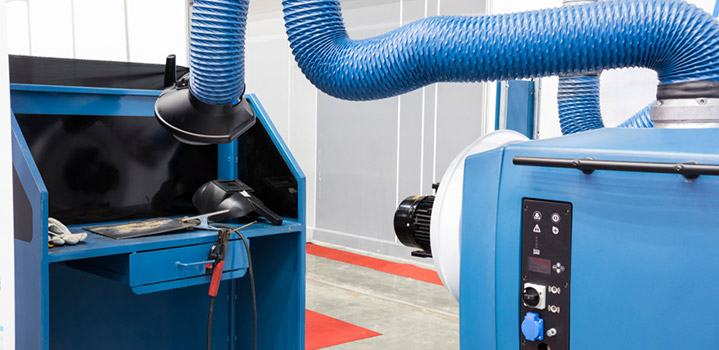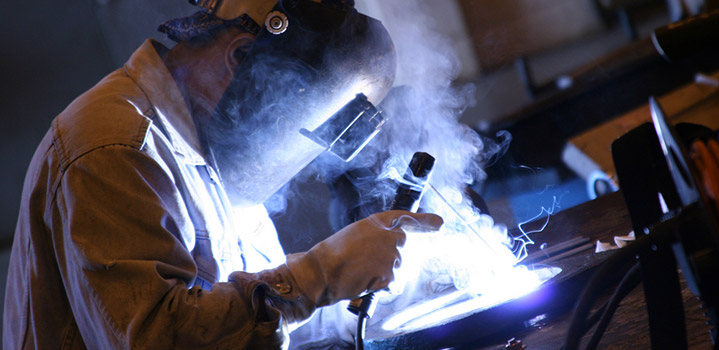The U.S. has more than 400,000 welders, cutters, solderers, and brazers working every day in our nation’s infrastructure, shipbuilding, automobile manufacturing, and other industries. It’s important employers continue to prioritize the safety of the men and women who fill these roles.
These jobs aren’t without their fair share of risks, including those from burns, intense light, and the dangers of welding fumes. Understanding those risks — and how to mitigate them — can protect your employees and your bottom line.
Types of Welding
The process of joining or cutting metal parts can be broken down into two groups. The first is pressure welding, which uses heat and pressure. The second is fusion welding, which uses heat alone. Fusion welding consists of three techniques — electric arc, which is the most common, followed by gas and thermite.
What Is Welding Smoke?
The one commonality these different techniques share is that they produce visible welding smoke full of dangerous gases and more than a dozen dangerous metals.
Depending on the filler used and the metal heated, this smoke can include carcinogens such as aluminum, antimony, arsenic, beryllium, cadmium, chromium, cobalt, copper, iron, lead, manganese, molybdenum, nickel, silver, tin, titanium, vanadium, and zinc, as well as gases like carbon monoxide, helium, and argon.
Are Welding Fumes Toxic?
Welding fumes are highly toxic and short-term exposure can cause eye, nose and throat irritation, nausea and dizziness. Long-term effects of welding fumes pose even more risk, including lung damage; lung, larynx or urinary tract cancer; kidney damage; fever; stomach ulcers, and nervous system damage.
Breathing argon while welding, or other hazardous gases, can lead to suffocation when in enclosed or poorly ventilated spaces. Check out our confined space safety tips for more information.

OSHA Regulations for Welding Fumes
OSHA regulations for welding fumes are extensive and pertain to a range of activities and requirements, from personal protection gear specifications and allowable exposure limits to welding fume ventilation and monitoring equipment. Per OSHA’s Hazard Communication standard, employers must provide their employees with information about the hazardous chemicals they may encounter and ensure that all employees using equipment, and their supervisors, are adequately trained both in machine operation and safety.
Employers must also provide ventilation systems that keep hazardous chemicals below exposure limits. These include general and local exhaust ventilation systems. General systems use natural or forced fresh air to keep welding fumes and smoke within safe limits. Local exhaust systems use a movable hood to remove welding smoke at the source.
Some industries, such as shipyards, have even more stringent requirements, so it’s best to consult with professionals for your organization’s specific needs. For example, an employee working in a confined space or with lead, beryllium, cadmium or mercury must use an airline respirator.
OSHA Requirements for Welding Galvanized Steel
Galvanized steel is coated by zinc, a metal that when heated and inhaled, can cause fever, nausea, and coughing, known as metal fume fever. When welding with a zinc-bearing base or filler metal, OSHA requires employers to provide general or local exhaust ventilation systems.
Stainless Steel Welding Hazards According to OSHA
Stainless steel is an iron-based metal coated by chromium, which protects it from rust. Stainless steel welding fumes release chromium, which according to OSHA, is highly toxic and can damage the eyes, skin, nose, throat, and lungs and cause cancer.
OSHA requires employers ensure no employee is exposed to an airborne concentration of chromium in excess of 5 micrograms per cubic meter of air (5 µg/m3), calculated as an 8-hour time-weighted average.
Dangers of Aluminum Welding Fumes
Aluminum welding health hazards include bronchitis and respiratory issues, and at worst, cancer. When heated during certain welding processes, aluminum releases the highly toxic gas ozone, a known cancer-causing agent.
Breathing Argon While Welding
Argon is a gas that displaces oxygen in the air and has the ability to cause suffocation. It is imperative to practice welding fume safety and follow all OSHA regulations relating to ventilation to ensure employees’ safety.

Welding Fume Safety Tips
It is an employer’s responsibility to ensure the safety of their employees, and following a Hazard Communication, staying up to date on OSHA regulations, and fully training both staff and supervisors can go a long way toward protecting them and your business.
Tip 1: Understand the Symptoms
It’s important that workers recognize when they have been affected by welding smoke. Oftentimes, these symptoms can be confused with a common illness or respiratory infection. It’s up to the employers and employees to examine possible underlying causes, such as a poor welding fume ventilation.
Tip 2: Practice Welding Fume Safety
Always stand upwind of toxic welding fumes when outdoors and never weld in a confined space unless you have the proper ventilation gear required by OSHA. Keep exhausts away from other employees and ensure that all air removed is replaced by fresh, clean air.
Tip 3: Know the Complexities
Navigating OSHA regulations can be tricky depending on your experience in the field and the continually changing requirements. OSHA regulations for welding fumes may differ whether you are in the shipbuilding, manufacturing, or construction industry. It’s important to know which requirements pertain to your business and practice safety in the workplace before you receive a notice.
Contact Safety by Design for Welding Safety Training
The safety consultants at Safety by Design can help you with your welding safety needs, from your Hazard Communication Plan to documenting and implementing OSHA welding fume requirements.
Contact Safety by Design today to learn more about safety compliance management, and most importantly, your employees safe.



